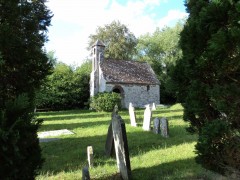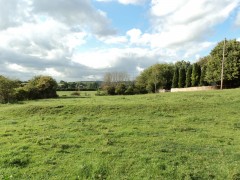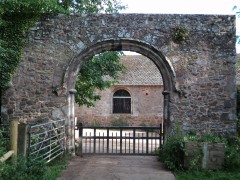Walking along the public footpath that eventually leads to Killerton House, from the small hamlet at Columbjohn to Columbjohn Wood you pass Columbjohn Chapel – above. The chapel you see today is a single roomed chapel built in a Romanesque Revival style in the middle part of the 19th century, but stands on the site of an earlier chapel and the original mansion house that was the home of the Acland family prior to the construction of Killerton House to the east.
 Columbjohn is recorded in 1086 in Domesday as ‘Colum’, by 1316 it is recorded as ‘Colump Johan’ this name is derived from Johannes de Culum who owned the manor in 1234 and literally means the ‘manor of John by the Culm river’ – the River Culm lies to the west of the chapel. The Aclands acquired the manor in the late 16th century and built a chapel here in the early 17th century. The mansion at Columbjohn was built in the late 16th century, reputedly on the foundations of an even older building.
Columbjohn is recorded in 1086 in Domesday as ‘Colum’, by 1316 it is recorded as ‘Colump Johan’ this name is derived from Johannes de Culum who owned the manor in 1234 and literally means the ‘manor of John by the Culm river’ – the River Culm lies to the west of the chapel. The Aclands acquired the manor in the late 16th century and built a chapel here in the early 17th century. The mansion at Columbjohn was built in the late 16th century, reputedly on the foundations of an even older building.
A geophysical survey of the field around the chapel has shown that the chapel we see today lies in the middle of the site of the former manor house demolished sometime after 1680 when Aclands moved their residence to newly constructed house at Killerton.


Pigeon Cottage behind the chapel (on private land) is reputedly built upon the 16th century foundation of the dovecote associated with the former manor house.
For more information, see the Historic Environment Record information about this site on Heritage Gateway.